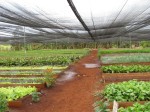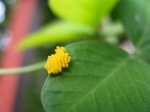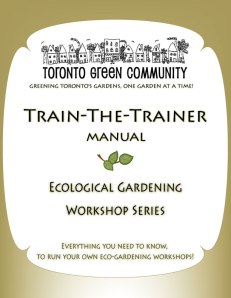Last week at the garden we had a brief discussion of some more “unconventional” approaches to growing food. We focused on three techniques, biodynamic farming, permaculture, and square foot gardening. These are three approaches with a lot of interesting information, and for gardeners not looking for a whole new framework to adhere to, they can be useful as a way to see your garden’s potential with new eyes. Permaculture and square foot gardening, specifically offer a great deal of creative ideas and freedom for the gardener, and once you start thinking of things in these ways it can lead to more and more innovation.
Biodynamic Farming: A method started in 1924 by Rudolph Steiner (also known for his involvement in developing the Waldorf School method) which treats the farm as an organism unto itself wherein the lifecycles of plants and animals create no external outputs and require no external inputs; it is a holistic closed-loop system. Some aspects of biodynamics are familiar to the average sustainable gardener, while others seem much more spiritual and esoteric.Generally though, farms which observe biodynamic practices, however unconventional, enjoy increased yields and soil health, so it is a compelling body of work.
One important aspect of Biodynamics (used by non Biodynamic farmers as well), is planting with the phases of the moon. The idea is that in the same way the moon pulls the tides, it pulls smaller bodies of water as well, making ground water closer to the surface. The four phases of the moon are related to different aspects of plant growth:
New moon – Balanced leaf and root growth. Plant and transplant above ground annuals that produce seeds outside the fruit. Plant short and extra-long germinating seeds
Second Quarter – Increased leaf growth. Plant and transplant above ground annuals that form seeds inside the fruit. Mow lawns for increased growth.
Full Moon – Increased root growth. Plant long germinating (two weeks) seeds, bulbs, biennials, perennials and root crops that need stimulated root growth. A good time for transplanting, pruning, and harvesting fruits for storage and drying. Mow lawns to slow.
Fourth Quarter – Resting period. Neither root nor leaf are active. Harvest, cultivate, prone destroy pests and weeds, harvest for storage and herbs for drying. Start compost piles.
The astrological sign the moon is travelling through changes every few days, and also exerts an impact on plant growth. Water signs (Cancer, Scorpio, and Pisces) are fertile and beneficial to many plants, root crops like earth signs ( Taurus, Virgo, and Capricorn) and flowers thrive in Libra. Fire signs (Aries, Leo and Sagittarius) and remaining air signs (Gemini and Aquarius) are barren and dry, and better for cultivating, harvesting, and controlling weeds and pests. Ideally, crops should be planted in the optimal moon phase and zodiac sign to promote their specific growth. For example, carrots or beets would do best planted when the moon is full and in Capricorn.Gardening by the moon calendars are available, and more in depth information can be found at www.gardeningbythemoon.com
Another aspect of biodynamics is the nine different soil preparations used to enhance soil fertility. These preparations include two different humus-creating techniques (filling a cow horn with manure or ground quartz and burying it from autumn to spring), and seven compost enhancing techniques which involve adding herbs such as yarrow, camomile and stinging nettle to compost in homeopathic doses.
Whether or not it can be made clear if biodynamic practices are substantially better than other organic approaches, biodynamic farming is gaining adherents, and has an international certification organization called Demeter, whose label you may have seen on health food products.
Permaculture: Developed by two Australians, Bill Mollison and David Holmgren in the 1970’s, permaculture is a combination of “permanent agriculture” or “permanent culture” and is a technique of designing agricultural areas as ecosystems which minimize work by overlapping functions. Rather than the division of crops and animals, wastes and inputs, seen in conventional agriculture, permaculture focuses on the integration and interconnectedness of life on the farm; using crop waste to feed animals and animal waste to feed crops instead of purchasing feed and fertilizer and discarding manure and plant litter.
Modeled after nature, permaculture believes that every aspect of the farm should serve more than one function and every needed function should be accomplished by more than one aspect of the farm. For example, rather than making garden paths out of compacted soil, they should be made from think layers of sawdust poured into trenches. The sawdust serves multiple functions by not only acting as a path, but also storing water runoff underground, recycling a potential waste product, and decomposing underground to later be incorporated into the compost. These same functions should also be performed by other parts of the farm or garden, by having cisterns or swales to collect water and other compost generating materials onsite.
The 12 principles of permaculture focus on working with nature in a variety of compelling ways. Guilds, for example, are groups of plants which grow symbiotically together, such as the well-known example of corn, beans and squash. Permaculture identifies many other guilds combining plants that require shade, trellising or nutrients with others that provide them. Permaculture also combines aspects of farms which are usually isolated, such as greenhouses and chicken coops, to create a more efficient greenhouse that is warmed by the chickens’ body heat.
As a design theory, permaculture is all about designing things properly so that there is a place for everything and everything in its place, and so that unnecessary work is minimized. This means putting initial thought into plantings so that the most frequently used and most labour intensive crops are located closest to the home, groundwater storage is done uphill so that gravity can be used to help irrigate, or using chickens and pigs to dig and till fields, allowing them to feed themselves in the process while reducing compaction from heavy machinery.
for more about permaculture check out www.permacultureprinciples.com
Square foot gardening: The least “unconventional” of the three, square foot gardening was developed in 1976, and is much more applicable to gardens than farms. The idea is that rather than planting in rows, if the garden is divided into small plots of one square foot (1’x1′). This approach is meant to waste much less space, be higher yielding, and reduce garden compaction as the square foot plots are organized into 4’x4′ beds, an area small enough that gardeners should be able to do all their work by reaching in from the perimeter. The number of vegetables to be planted in each plot is dependent on the relative size of the full-grown crops. Larger crops, such as peppers or broccoli will have only one plant per square foot, while crops that take up less ground area, such as spinach or carrots can have up to 9 or 16 plants respectively.
Besides the details of garden layout, square foot gardening practices are focussed on increasing yields from small spaces, techniques which can be used in conventional gardens as well. Trellising, for example, is a key aspect of gardening in small spaces. Bartholemew promotes trellising not only peas and beans, but larger crops: tomatoes, zucchini, and even watermelons (provided the variety used doesn’t surpass 8 pounds). The idea of maximizing vertical space continues underground as well; square foot gardening also promotes digging extra deep beds for underground crops like leeks and potatoes and then gradually filling in soil as the shoots break through, as a way to force the plants to grow taller than they otherwise would and increase yields. In this high yielding intensive style of gardening, maintaining extremely healthy soil is of the utmost importance, so it is critical to add compost, other organic amendments and try to incorporate green manures or cover crops in the off season
<!–[if gte mso 9]> Normal 0 <![endif]–>





















